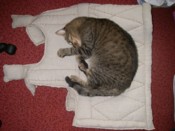Prayer Bead Production and use in Medieval England
By Anna Gottschall
Rosetta: Papers of the Institute of Archaeology and Antiquity, Issue 4 (2008)
Introduction: From ancient to modern times, in Christianity and other world religions, beads have been employed to assist the faithful in prayer. The word ‘bead’ derives from the Old English word ‘ebed’, originally meaning to pray or request, and was used to describe groups of beads which were loosely strung together. During the medieval period these strings of beads were used by Christians as mnemonic aids to physically count their prayers. Initially, this was attributed to the Pater Noster (Lord’s Prayer), later the Hail Mary and then the rosary as we know it today. As well as being devotional tools these objects were probably the most common item of jewellery across all classes, and this made them an everyday object frequently accessed by religious orders and the laity.
I propose to evaluate what the evidence reveals about the production and composition of prayer beads and rosaries, to consider the limits of these sources and to discuss the problems that emerge in interpretation of the evidence. In terms of production I aim to address several questions: Who made prayer beads? Where were they produced? How was production organised? And what can be determined about production methods? To do this I will consider evidence from excavation reports from the City of London and Constance in Germany, an artistic representation of a Paternosterer from the Stadtbibliothek in Nurnburg and historical records concerning bead production from Paris, Rome and London.
http://www.rosetta.bham.ac.uk/Issue_04/Gottschall.pdf
Prayer Bead Production and use in Medieval England
Modérateur : L'équipe des gentils modos
Grég le furet
56
Miles britto-romain an 5OO.
Letavia <a href="http://letavia.canalblog.com/" target="_blank">http://letavia.canalblog.com/</a>
56
Miles britto-romain an 5OO.
Letavia <a href="http://letavia.canalblog.com/" target="_blank">http://letavia.canalblog.com/</a>

